- News
- Reviews
- Bikes
- Components
- Bar tape & grips
- Bottom brackets
- Brake & gear cables
- Brake & STI levers
- Brake pads & spares
- Brakes
- Cassettes & freewheels
- Chains
- Chainsets & chainrings
- Derailleurs - front
- Derailleurs - rear
- Forks
- Gear levers & shifters
- Groupsets
- Handlebars & extensions
- Headsets
- Hubs
- Inner tubes
- Pedals
- Quick releases & skewers
- Saddles
- Seatposts
- Stems
- Wheels
- Tyres
- Tubeless valves
- Accessories
- Accessories - misc
- Computer mounts
- Bags
- Bar ends
- Bike bags & cases
- Bottle cages
- Bottles
- Cameras
- Car racks
- Child seats
- Computers
- Glasses
- GPS units
- Helmets
- Lights - front
- Lights - rear
- Lights - sets
- Locks
- Mirrors
- Mudguards
- Racks
- Pumps & CO2 inflators
- Puncture kits
- Reflectives
- Smart watches
- Stands and racks
- Trailers
- Clothing
- Health, fitness and nutrition
- Tools and workshop
- Miscellaneous
- Buyers Guides
- Features
- Forum
- Recommends
- Podcast
TECH NEWS
First Ride: Trek Madone 9 Series
The new Trek Madone 9 Series is a sparky pro-level aero road bike that offers an excellent ride quality.
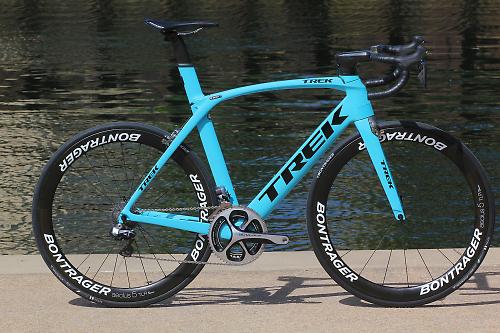
In brief, the key things you need to know are these:
• Trek says that by using Kammtail Virtual Foil (KVF) tube profiles for the frame tubes, fork legs and seatpost it has been able to produce the fastest aero bike out there.
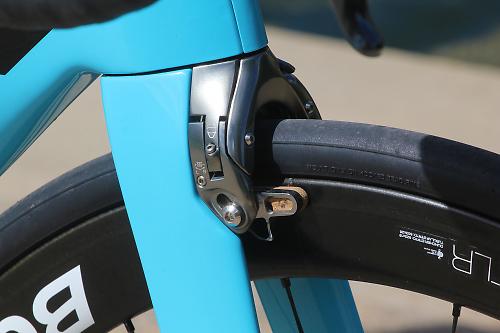
• The new Madone features a huge amount of integration including proprietary brakes, fully internal cables/wires, and a hidden Di2 battery and junction box if you go for electronic shifting.
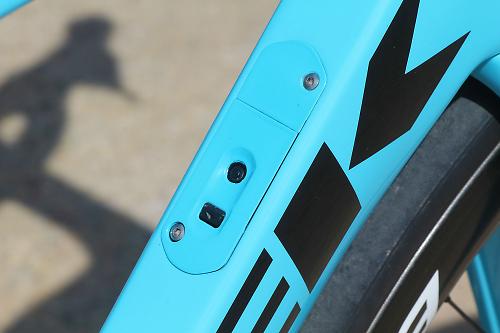
• Trek designers have introduced what they call ‘IsoSpeed technology’ where the seat tube comprises an outer aero tube that’s attached to the rest of the frame, and a separate inside tube that’s attached only at one point: just above the bottom bracket. The idea is that the inside tube can flex to provide more comfort than you’d otherwise get.

I spent a couple of days with Trek at its HQ in Waterloo, Wisconsin back in May to check out the new Madone, get the full story from the designers, and ride the bike. My Garmin says we rode for 1:20hrs on the first day and 3:30hrs on the second day. That second ride was fairly hilly with 1,300m of elevation gain. It was mostly rolling countryside with a couple of longer climbs thrown in.
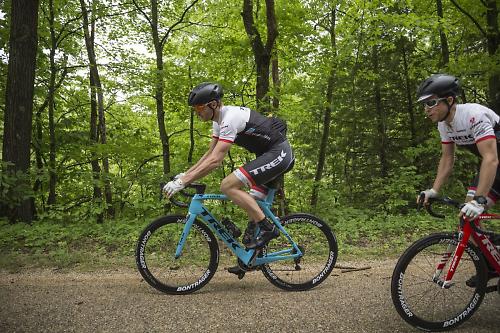
What I can’t tell you about from that ride is the Madone’s aero performance – that’s impossible. I’d suggest you check out the Madone Whitepaper that Trek has produced for all the details there (if it’s not already there, it’ll soon be published on Trek’s website www.trekbikes.com). It tells you how Trek went about the design process and how the engineers arrived at the finished product.

I can tell you about the IsoSpeed decoupler. This is a system borrowed from the Domane that allows the seat tube to move independently of the rest of the frame.
Let’s be honest, some aero road bikes can feel pretty harsh because of the aspect ratios of the tubes. Deep-section tubes often don’t flex much at all so you feel every little irregularity in the road.
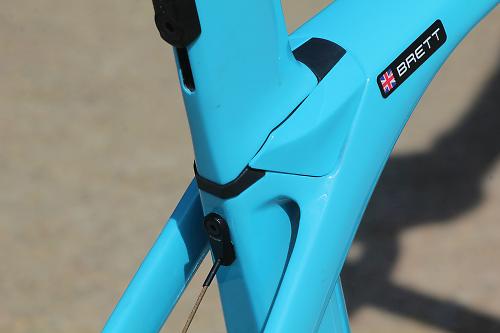
To cut a long story short, the IsoSpeed decoupler works. The amount of saddle movement you get from IsoSpeed isn’t huge, but it is appreciable. There’s just a small amount of give there that keeps the ride feeling smooth and takes the edge off bigger hits. Cast all thoughts of mountain bike suspension from your mind. It’s nothing like that; not even close. It’s just a touch of cushioning to cancel out road buzz and round off the spiky bits.
If you want a figure, Trek claims that the new Madone offers “an incredible 57.5% improvement in vertical compliance over the nearest competitor”. Everyone loves a marketing figure, right?
Personally, I found the Madone to be really comfy, especially for an aero bike. I’ve not had the chance to ride it all day long, but I felt good in the saddle at the end of that 3:30hrs ride I mentioned. The 25mm Bontrager R4 tyres doubtless helped there, and there’s enough room for you to fit 28s if you want an even larger chamber of air between you and the road, but the IsoSpeed system is certainly doing a job.

The Madone whips up to speed very quickly. The 58cm bike I was riding, built up with a Shimano Dura-Ace Di2 groupset and Bontrager Aeolus 5 TLR wheels, weighed in at 7.0kg (15.4lb, without pedals). Trek’s Émonda is lighter but, as you probably know, aero beats weight in most situations (yes, it’s more complicated than that, but let’s not get caught up in that debate here). The point is, the Madone is quick off the mark and it climbs well, the huge bottom bracket barely budging when you get out of the saddle to eke out a bit more power on the steep sections.
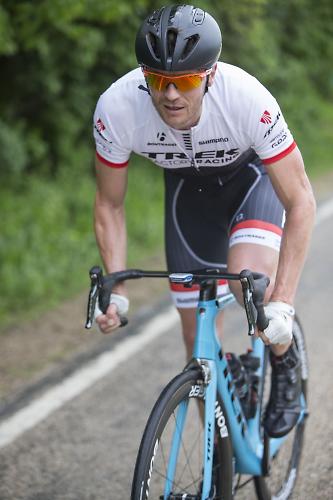
I’d say that the bike is perhaps an even more impressive descender. Any bike can go downhill well in a straight line but the Madone is also a class act through the high-speed bends, offering excellent accuracy and a really controlled feel. I don’t think that I found its limits on our two rides.
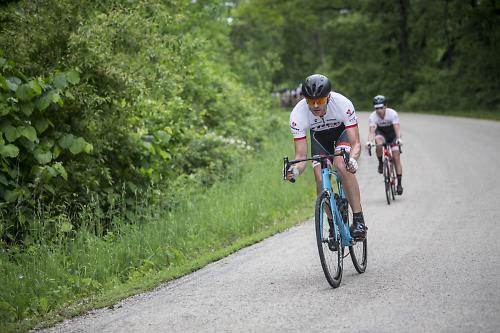
Bontrager’s direct-mount centre-pull brakes felt good too. The bite on the carbon-fibre rims wasn’t as strong as you get with aluminium, but that’s always the case. Our rides were dry so I can’t comment on the performance in wet conditions, but I always felt in total control here.
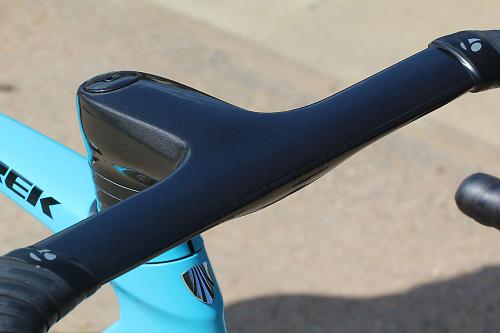
One other component that’s worth mentioning is the combined handlebar and stem. As you can see from the pictures, the profile of the top of the bar is super-thin, so the frontal area is small. I think it looks super-cool but I did wonder whether riding with my hands perched up there would be uncomfortable. It turns out that’s not the case. You get a big palmful of bar to hold on to and the trailing edge – the bit your thumb hooks round – is squared off rather than pointed. I wouldn’t say it’s quite as comfortable as a round bar, but it’s not going to bother you.
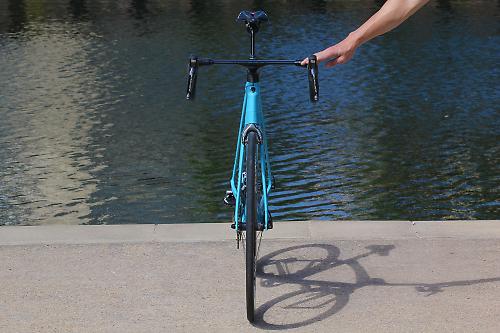
You can see hardly any cables/wires on the new Madone; they’re all hidden away internally. The same is true of the Di2 battery and junction box if you opt for a model with electronic shifting, although you can still access the button that fine-tunes the shifting via a little window in the down tube. If you opt for a bike with mechanical shifting you get a barrel adjuster located in that position instead. If you want to bring the brake pads in closer to the rims, though, that’s an Allen key job; you can’t do it on the fly.
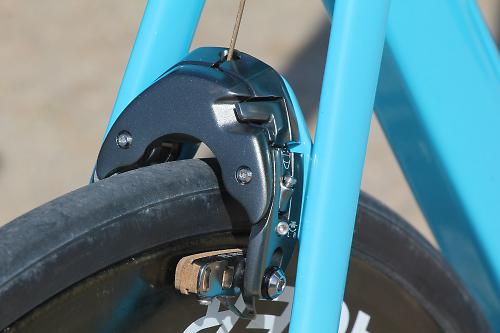
The Madone that I rode was put together through Trek’s Project One custom bike programme although it’s pretty much the same spec as the Madone 9.9, which also comes with a Shimano Dura-Ace Di2 groupset and Bontrager Aeolus 5 wheels. That bike retails at £9,000. The difference is that I had my frame painted in road.cc colours rather than going for a standard finish.
Go to our other story for other Madone 9 Series prices.
So, my initial ride impressions are very positive. I think that Trek has produced a peach here. How easy it is to maintain, I’ve yet to discover. Changing a brake cable looks complicated, but perhaps I’ll be surprised. We now have this bike at road.cc for a full test, so I’ll cover maintenance stuff in that, once I’ve got my fingers oily.
In the meantime, go to www.trekbikes.com for more details.
Mat has been in cycling media since 1996, on titles including BikeRadar, Total Bike, Total Mountain Bike, What Mountain Bike and Mountain Biking UK, and he has been editor of 220 Triathlon and Cycling Plus. Mat has been road.cc technical editor for over a decade, testing bikes, fettling the latest kit, and trying out the most up-to-the-minute clothing. He has won his category in Ironman UK 70.3 and finished on the podium in both marathons he has run. Mat is a Cambridge graduate who did a post-grad in magazine journalism, and he is a winner of the Cycling Media Award for Specialist Online Writer. Now over 50, he's riding road and gravel bikes most days for fun and fitness rather than training for competitions.
Latest Comments
- Aluminium can 2 hours 14 min ago
Its not a booby trap as it says clearly right on the side the outcome of cutting it. The same as aerosol paint cans have warnings not to...
- eburtthebike 2 hours 34 min ago
A comedian with a purpose can achieve more than the politicians e.g. Zelesky.
- Hirsute 4 hours 10 min ago
Sounds a bit specific though given 90% are bought on some sort of finance.
- Rekrab 4 hours 28 min ago
MORE LANES, MORE LANES!!!!
- Simon E 4 hours 35 min ago
The numbers don't tell anything like the whole story....
- Simon E 5 hours 6 min ago
Just squirt some thick grease all over his side windows and door panels. If you're feeling really uncharitable you could throw some sand at the...
- David9694 5 hours 46 min ago
check under 'W'for "What cars do to people"
- Global Nomad 6 hours 27 min ago
good to see you're testing the farsports wheels - hope to see road.cc continue to expand the range of brands it considers. These or the shallower...
- chrisotherwise 7 hours 1 min ago
Sadly very normal. And the sand contains loads of evil little shards of flint.



































































Add new comment
9 comments
Its a lovely looking bike but that rear brake looks rather over complicated...at least its not under the chainstays though!
Call me old fashioned, but it seems strange to me why over the years the down tubes and head tubes have steadily increased in size, once 1" headsets were the norm, then 1 1/8" 'threadless' were praised and more recently this wasn't deemed strong enough by the manufacturers so we end up with 1 1/8" top and 1 1/4" bottom headsets being common. The same has happened with the now massive down tubes, they make my 8 year old Aluminium frame look anorexic!
Now in the guise of the trend for 'Aero' frames the companies are slowly retreating back to the smaller diameter headsets, but charging a massive premium, hoping no one will remember the days when this was the standard.
Why isn't a small profile down tube strong enough anymore ?, surely in the name of reduced aero drag it would be possible to keep the frame profiles very thin yet strong enough to be fairly rigid. Just look at the infamous Lotus bike that Chris Boardman rode to fame all those years ago, that is the extreme that was possible 20+ years ago.
Now the frames are made so super-duper rigid that to make them comfortable extra softness has to be designed in (e.g. the IsoFlex design), this seems a lot effort to re-create the same feel of older frames built decades ago, but I guess that's progress!!
I think this is mostly to do with the max 3:1 ratio of the 'tube' that the UCI will allow and how they optimise within that parameter. You can make a thin 3:1 section but it will have to be relatively heavy. No bones on the track but on a road bike it matters a lot more, so they are trading 'diameter', weight and profile. Or at least their software is
Makes no sense at all for a consumer bike of course and unless you really are racing it does all seem a little, errr, pointless.
Having said that if I were racing I can see the benefit of a single aero bike, no need to double up on road and TT bike - for a club rider at least...
Surely they are getting to the point that a hub brake would be the most aerodynamic option...?
£10k. I should hope it rides well. Bikes are getting really pricey at the top end eh.
Dealers will be thrilled at the serviceability...
Many can't (or choose not too) stop the current Di2 madonnes rattling...
Customers will be equally chuffed at TT bike service charge levels.. which is only right as that's how long it takes..
Great incentive for owners to take ownership of the maintenance and not just the riding.. save a fortune..
Looks much nicer than the new Venge.
Wonder what a head to head comparison ride report will reveal?
Looks ace in Road.CC blue I must say.